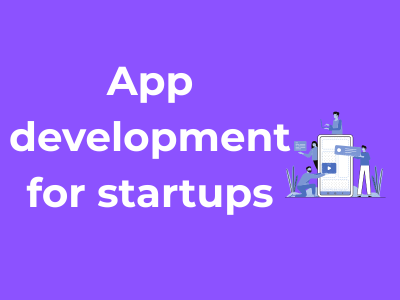Hey there, budding entrepreneurs and startup dreamers! Let’s dive into the very basics of app development. Yes, we’re talking about the solid foundation every startup needs — because before you start building, you’ve got to ensure that the ground beneath you is rock solid, right?
Why Does Your Startup Need an App?
First things first: do you even need an app? This isn’t just about following trends. If an app solves a key problem for your audience and aligns with your business goals, then absolutely, it’s time to roll up your sleeves! Whether it’s a niche app for your service, a tool to engage users, or a platform to drive sales, make sure the app is solving a real problem on mobile phones and web.
Understand Your Market and Users
One thing is crucial before you write a single line of code: knowing your target audience. Who are they? What do they need from your app? How tech-savvy are they? While this sounds obvious, skipping or rushing through research puts many startups on shaky ground.
Take some time to create user personas — models of your ideal app user. Really dig into their demographics, challenges, goals, and behavior. And don’t forget to ask yourself: Who is your competition and what are they doing differently? The more you understand the landscape, the better equipped you’ll be to create something that stands out.
Core Questions to Ask Before Starting
Ready to dive in? Not quite yet. Here are a few key questions you should answer first:
- What problem does my app solve? If it’s not solving a pain point for someone, it’s not practical.
- What is my minimum viable product (MVP)? Start lean. Build the core features your users need most, and refine later.
- What’s my budget and timeline? App development can get costly if you don’t have clear boundaries on both fronts.
By answering these foundational questions, you’ll ensure your efforts are focused, effective, and, most importantly, targeted towards creating a solution that resonates with your audience.
Plan Your Tech Stack
You don’t need to be a tech wizard yourself (phew), but it’s important to know at a high level what tools and technologies your app might require. Keep in mind factors like scalability and maintenance. Here’s where consulting with specialists or experts on your development team becomes super valuable.
Think Ahead About Monetization
Let’s get to the exciting part: dreaming about those revenue streams! Whether your app will offer in-app purchases, ad placements, subscription plans, or serve as a bridge to your core product, it’s important to bake in monetization strategies early.
But remember this golden rule: always prioritize user value over quick profits. You want users to love your app first and foremost. Making money is great, but building loyalty is even better.
Sketch, Plan, and Prototype
Before your app exists in all its glory, start with wireframes. These basic blueprints help visualize what each screen will look like and how users will navigate throughout the app. Think of wireframes as sketches that help you refine your app’s functionality. From there, move to prototypes, which will allow you to spot usability issues early on.
Remember, it’s much easier (and cheaper) to spot problems in a sketch than in a finished app!
Choosing the Right Approach: Native vs Hybrid vs Web Apps

So you’ve decided to build an app for your startup—congratulations! Now comes one of the first and trickiest decisions: What kind of app should you create? This choice boils down to three main approaches: Native apps, Hybrid apps, and Web apps. Each has pros and cons, and the best choice depends on your unique goals, budget, timeline, and target audience. Let’s break it all down, one step at a time.
Native Apps: The Powerhouse Performers
Native apps are like the superstars of the app world. These are built specifically for a single operating system—iOS or Android. For example, an iOS native app is coded in Swift or Objective-C, while Android apps are typically written in Kotlin or Java. The payoff? They deliver top-notch performance, smooth animations, and seamless access to device features like cameras or GPS.
Advantages:
- Unbeatable performance and faster responsiveness
- Enhanced user experience tailored to the OS
- Ability to leverage platform-specific features
Challenges:
- Higher development costs (since you’ll be building for each platform separately)
- Longer development times
If your startup requires superior speed and functionality—for instance, gaming or high-performance finance apps—a native app could be worth the investment.
Hybrid Apps: The Efficient All-Rounders
Hybrid apps are like the multitaskers who strive to find a balance. Designed to work across both iOS and Android, these apps are built using web technologies like HTML, CSS, and JavaScript, wrapped in a native shell. Popular frameworks like Flutter and React Native make hybrid apps a compelling choice for startups that want cost-effectiveness without compromising too much on performance.
Advantages:
- One codebase for multiple platforms, saving time and money
- Quicker development and deployment
- Access to some native features through plugins or APIs
Challenges:
- May not feel as “smooth” or tailor-made as native apps
- Performance can sometimes lag in complex use cases
Considering a hybrid approach? They’re perfect for startups on a budget or for apps that don’t require every bell and whistle in terms of performance (e.g., simple e-commerce or content apps).
Web Apps: The Fuss-Free Minimalists
Web apps are the lightest option and run directly in a browser instead of being downloaded from app stores. Think of them as souped-up websites that can function like apps. Built using web technologies (HTML, CSS, JS), these apps are generally faster and cheaper to develop.
Advantages:
- No app store approvals, meaning faster rollouts and updates
- Accessible across multiple devices and platforms
- Lower cost since it requires less complexity
Challenges:
- Limited access to device-specific features
- Requires internet connectivity for optimal performance
- May lack the polished, app-like feel
If your startup focuses on reaching the widest possible audience on launch (like simple productivity tools or content platforms), web apps are your best bet.
Making the Right Choice
Still feeling torn? Here’s a smart way to decide:
- Determine your top priorities: Is it speed? Cost? Functionality?
- Analyze your target audience: Which platforms do most of your users prefer?
- Balance today’s needs with tomorrow’s growth plans: Can your choice scale?
Remember, there’s no one-size-fits-all solution here. The right choice is the one that fulfills your unique business goals while staying within your budget and timeline. And whatever option you choose, there’s always room to tweak and improve down the road!
Building on a Budget: Tips to Optimize Development Costs

Let’s face it: as a startup, you’re probably working with a tight budget and ambitious goals. Developing an app can seem daunting when you’re juggling finance, timelines, and the dream of creating something impactful. Don’t worry; it’s possible to build an app that doesn’t break the bank. Here’s how!
1. Define Your MVP (Minimum Viable Product)
Start small. You don’t need an app with all the bells and whistles right away. Your MVP should focus on the core features that solve your audience’s primary problem. Not only does this save costs upfront, but it also allows you to launch sooner and gather feedback for future updates. Remember, you can always add more functionality after your app gains traction.
2. Prioritize Functionality Over Aesthetics
Of course, you want your app to look fantastic, but functionality should always come first. Fancy animations and extreme customization can quickly eat away at your budget. Stick to simple, user-friendly designs. Tools like pre-built templates or existing UI kits can offer you a polished look without costing a fortune.
3. Choose the Right Development Methodology
- Agile Development: This iterative approach keeps you in control of timelines and budgets. Work in sprints and evaluate progress regularly. This way, you’re investing wisely and can pivot if needed without losing substantial funds.
- Open-Source Tools: Wherever possible, utilize open-source frameworks and libraries. They’re cost-free and supported by large developer communities, which is a win-win.
4. Outsource Wisely
If hiring an in-house team seems costly, outsourcing might be your ticket to affordability. However, be strategic:
- Hire freelancers from reputable platforms, ensuring you check reviews and portfolios.
- Consider nearshore or offshore developers, as they often provide competitive rates while maintaining quality.
- Look for agencies or vendors who specialize in working with startups. They often understand the constraints and challenges you face.
Pro tip: Communication is key when outsourcing. Regular check-ins with your team can save you time and ensure they’re delivering what you envision.
5. Leverage Low-Code/No-Code Platforms
Not every app needs to be built from the ground up! Tools like Bubble, Adalo, or Glide allow you to create fully functional apps without diving deeply into coding. These platforms are especially useful for prototyping or validating your concept at a fraction of the cost.
6. Plan Your Budget in Stages
Instead of pouring your entire budget upfront, pace your spending across different stages. Allocate funds as you achieve milestones—this ensures you don’t run out of cash mid-development. Bonus: phased spending also allows for adjustments based on feedback or market change.
7. Use Analytics to Avoid Costly Mistakes
Use analytics tools to monitor user behavior during early testing. They provide insights into what users love and what’s unnecessary. This data can guide future iterations, helping you double down on what works rather than wasting resources on features no one wants.
8. Don’t Forget Maintenance Costs
Building the app is just the first step. Maintenance, updates, and bug fixes require ongoing investments. Planning for these costs upfront ensures smooth operation post-launch without any unpleasant surprises.
Must-Have Features for Startup Apps in Competitive Markets
Let’s face it—startup apps are entering a competitive arena where standing out isn’t just an option, it’s a necessity. So, what exactly does it take to make your app shine brighter than the rest? Don’t worry, I’ve got you covered! Here’s a rundown of the must-have features that can elevate your app and truly make it a winner in a crowded marketplace.
1. Seamless User Experience (UX): A Non-Negotiable
First things first: your app has to be easy to use. Users are quick to abandon apps that make them work too hard. Think of UX as your app’s first impression—it has to be smooth, intuitive, and visually appealing. Here’s what users love:
- Minimal clicks to achieve an intended result.
- Clear navigation and actionable buttons that don’t leave them guessing.
- Beautiful design that matches your brand identity.
Remember, a clunky app with a learning curve is more likely to get uninstalled. Smooth interface? Essential.
2. Personalization: Tailor the Experience
Gone are the days of one-size-fits-all apps. If your startup app can deliver a personalized user experience, you’re already ahead of the game. Features like:
- Custom recommendations based on user behavior.
- Personalized alerts or messages.
- A user profile or dashboard that adapts to their preferences.
These small touches make users feel valued and understood—key ingredients for fostering loyalty.
3. Offline Functionality: Convenience on the Go
Not everyone is always swimming in Wi-Fi or data coverage. Giving users the ability to access core features offline can be a total game-changer for your app. Whether it’s storing notes, playing pre-downloaded content, or updating tasks that sync later—this feature screams convenience.
4. Swift and Secure Payment Options
If your app involves transactions, you need a payment process that’s fast, simple, and trustworthy. Incorporate multiple payment methods like credit cards, PayPal, or digital wallets, and always make security paramount. Utilize encryption and comply with regulations like PCI-DSS to ease users’ minds.
5. Push Notifications: Stay Engaged Without Being Pushy
Ah, push notifications—a double-edged sword. When used wisely, they’re a fantastic tool for re-engaging users and keeping them in the loop. However, spam users with irrelevant buzz, and they’ll likely mute or delete your app.
Keep your notifications:
- Relevant and timely.
- Actionable (e.g., exclusive offers or useful reminders).
- Customizable so users can choose what they want to be notified about.
6. Strong Security Measures: No Compromises
In the age of data breaches, people are growing more concerned about their privacy. Your app needs to show you value their trust by implementing robust security measures like:
- Encrypted communication protocols.
- Two-factor authentication (2FA) for accounts.
- Regular security testing and updates.
Play it safe, and your users will thank you.
7. Analytics and Feedback Mechanisms
If you’re not tracking user behavior, how will you know how to improve? Including analytics tools in your app can tell you what features are working and what needs tweaking. Add feedback forms to let users share their thoughts directly from the app—an invaluable resource for continuous improvement.
How to Find the Perfect Development Team or Vendor
So you’ve got a brilliant app idea, but now comes the true challenge: finding the right people to make it happen. This is a critical step that sets the tone for the success of your venture. Let’s chat about how you can secure a dream team or vendor that will turn your vision into reality while keeping your business goals on track.
1. Define Your Needs Clearly
Before you even start Googling ‘best app developers,’ take a step back and define what you’re looking for. The clearer you are about your project requirements, the better equipped you’ll be to find a team that matches your needs:
- What’s your app’s purpose? List out core functionalities.
- What’s your budget? Be realistic here—this will save time.
- What’s your timeline? Include milestones and a final launch date.
With these nailed down, you’ll have a roadmap to evaluate potential partners.
2. Prioritize Experience and Knowledge
The development landscape can get tricky, so you want people who know what they’re doing. Look for teams or vendors with:
- Experience in building apps similar to yours: For example, if your app involves AI, do they have relevant projects under their belt?
- Knowledge of your industry: Whether it’s fintech, healthcare, or e-commerce, domain expertise adds extra value.
- A rock-solid portfolio: Case studies and app launches they can show off with pride.
Don’t settle for vague promises—real success stories speak volumes.
3. Communication is Key
Your development team isn’t just there to code; they’re partners in your journey. Effective communication can either make or break this relationship. Here’s what to consider:
- Language alignment: Are they fluent in your business language?
- Project management processes: Do they use Agile, Scrum, or other methods to ensure transparency and updates?
- Availability: Will you have regular check-ins and direct access to your project managers or developers?
A vendor that listens, asks the right questions, and is responsive will likely understand your vision better.
4. Compare Pricing vs Value
It might be tempting to go for the cheapest option, but be cautious! While staying within budget is important, hiring solely based on cost can backfire if the work quality is subpar. Look for teams that offer:
- A transparent and detailed breakdown of costs.
- Flexibility with payment models: Fixed-price, hourly rates, or retainer contracts.
- The ability to deliver tangible value for every dollar.
Remember, you’re not just paying for code—you’re investing in expertise and creativity.
5. Test Before You Commit
It’s okay to dip your toes in the water before plunging all in. Here’s how you can test them:
- Request a small trial project before signing a contract.
- Ask for references and testimonials—and don’t hesitate to reach out to their previous clients.
- Observe how they handle your inquiries during the initial consultation. Are they proactive and thorough?
This ‘trial period’ will give you a sense of their reliability and what it’s like to work with them.
6. Trust Your Gut
Finally, trust your instincts. If something feels off—whether it’s a lack of transparency or mismatched communication styles—don’t ignore those red flags. A great partnership is built on mutual trust and a shared vision.
Ensuring Scalability: Preparing Your App for Growth
Congratulations! You’ve started building your killer app, and you’re prepared to take the competitive market by storm. But here’s something many first-time founders overlook: what happens when your app truly takes off? Can it handle thousands, or even millions, of users without crashing? Scaling your app is a critical part of its success story, and lucky for you—we’re about to dig into exactly how to prepare your app for explosive growth.
What is Scalability, Anyway?
In simple terms, scalability refers to your app’s ability to grow seamlessly without breaking under the pressure of increased demand. Think of it like this: starting small is awesome (and necessary), but you’ve got to plan ahead to ensure your app has the potential to serve a larger audience without hiccups. Without a scalability plan in place, an influx of users could lead to slow performance, bugs, or worse—a complete crash!
Start Early by Picking the Right Foundation
Much like building a house, the foundation of your app is crucial to its growth. When choosing the technical stack (the combination of frameworks, tools, and programming languages for development), pick one that’s not only reliable but future-proof. Popular options include:
- Cloud Hosting Services: Providers like AWS, Google Cloud, or Microsoft Azure are excellent for scaling flexibility. With cloud hosting, you can easily add resources as demand grows.
- Scalable Databases: Choose databases capable of handling massive datasets, like PostgreSQL or MongoDB, which allow easy scaling as you gain users.
- Microservices Architecture: Instead of building one massive app, consider breaking it into smaller, manageable pieces (or microservices) that can be scaled independently.
A solid foundation not only prepares you to grow but also keeps your app running smoothly during those inevitable traffic spikes.
Think Beyond Today’s Traffic
Picture this: your marketing campaign goes viral, and suddenly ten times the number of users are signing up. Exciting, right? But only if your app is ready to keep up! Plan for growth by doing the following:
- Limit Unnecessary Features Early On: While it’s tempting to pack your app with features, it’s better to start lean. Focus on a Minimal Viable Product (MVP) and optimize performance for your core functionalities. You can always add more later.
- Load Testing: Regularly stress-test your system to simulate heavy traffic and identify bottlenecks. Tools like Apache JMeter or Gatling can help.
- Implement Caching Mechanisms: Minimize database queries and improve speed with caching solutions like Redis or Memcached.
These practices will help you stay ahead of surges in traffic and deliver a seamless user experience.
Continuous Monitoring = Continuous Success
Building a scalable app isn’t a set-it-and-forget-it process. You need to monitor performance constantly. Tracking tools like New Relic or Datadog can provide real-time insights into user behavior and app performance, helping you resolve issues before they turn into headaches.
Launching and Beyond: Post-Release Strategies for Startups
Launching your startup’s app is an exciting milestone, but here’s the thing—launch day is really just the start of the journey! The real work begins post-release, and having a well-thought-out strategy for what comes next is essential. No matter how flawless your app might seem, this phase will shape how it grows, performs, and adapts to your users’ needs. So, let’s dive into the essentials of post-launch strategies with tips to keep your app journey smooth and fruitful.
1. Gather Feedback Like a Pro
After the launch, feedback is your best friend. Your early adopters are a treasure trove of insights. Create multiple avenues for users to share their thoughts—think in-app surveys, email check-ins, or reading through app store reviews. Be sure to actually listen to their comments! Are they facing bugs? Are they craving new features? Users love to know their voices are heard, and addressing their feedback helps build loyalty and trust.
2. Regularly Update and Improve
Let’s put it this way—your app should never be “done”. Successful startup apps stay relevant because they evolve. Plan regular updates to add features, improve usability, and patch up anything that’s not working. It’s also a great marketing opportunity—each update is a chance to re-engage your audience. But don’t overwhelm users with too many changes at once—pacing is key!
3. Keep Users Engaged
Building an app is not just about getting downloads; it’s about keeping users coming back. To stay top of mind, consider push notifications (sparingly—no one loves spam!), email campaigns, or even gamifying aspects of your app. Rewards, loyalty programs, or helpful reminders can be great motivators. The goal? Making your app an indispensable part of your users’ lives.
4. Monitor Performance Metrics
Numbers don’t lie, and tracking app performance metrics will tell you what’s working (or flopping). Keep an eye on key indicators like:
- Retention Rate: How many users stick around after download?
- Daily Active Users (DAU): How many people use the app every day?
- Crash Reports: Is the app behaving as expected?
- User Reviews & Ratings: Trends here can provide insights for improvement.
Use analytics tools and dashboards to identify patterns and make data-driven decisions for your app.
5. Expand Marketing Efforts
Just because your app is live doesn’t mean your marketing stops. Post-launch is a perfect time to ramp up your promotional efforts. Consider running social media campaigns, collaborating with influencers, or continuously pitching your app’s value to tech blogs or niche publications. Stay proactive and visible—your audience is expanding, and you don’t want potential users to miss out.
6. Be Ready for Scaling Up
If all goes well (and we hope it does!), your app will grow. Ensure your backend systems are ready to handle an increase in users and their activities. The last thing you want is a frustrating app slowdown or crash at the peak of your success. Keeping a reliable IT team on standby will help tackle sudden growth gracefully.
7. Learn from Your Competition
Always keep an eye on what similar apps in your industry are doing. Are they adding features? Marketing in new ways? Building partnerships? While you don’t want to be a copycat, staying informed ensures you’re not caught off-guard by competitors’ moves.











